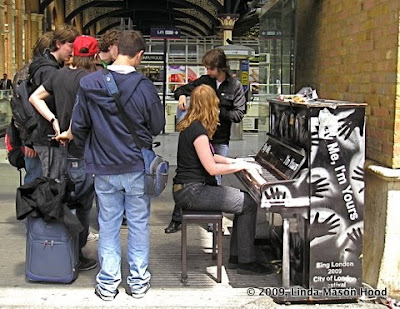Several times throughout the day we saw oddly painted pianos sitting on the sidewalk or in public atriums. This one, in Liverpool Street Station, was the only one we saw being played.

Later I learned that these pianos were part of an urban art project entitled Play Me, I'm Yours. This project by Luke Jerram placed 30 pianos in heavily populated public places. The intention was to create personal amusement or perhaps spontaneous street theater as people sat down to play the pianos. The exhibit lasted three weeks, then the pianos were given to schools and community groups.
After lunch at Ye Olde Mitre Tavern (see my Sacred Spaces post) Maurene and I did a bit of window shopping in the Hatten Garden jewelry district, an area bounded by Holborn, Gray's Inn Road, Clerkenwell Road, and Farringdon Road. Click here for a map. The jewelry was dazzling, shop after shop. Best to leave quickly and avoid temptation!
Next we looked at the half-timbered Tudor buildings on High Holborn. Very pretty buildings, and very old -- they date back to 1586.


The half-timbered buildings form the northern side of the Staple Inn. Behind them, lovely red brick buildings surround a peaceful landscaped interior garden.



Staple Inn is the last surviving Inn of Chancery. The Inns of Chancery, dating back to 1344, originally served as offices for clerks of chancery (a type of law). Later, the inns provided not only office space but also living quarters for the chancery lawyers who were called solicitors. Until 1642 the Inns of Chancery also provided initial training for barristers. It's interesting to note that solicitors practiced a different type of law than barristers, but today's lawyers in Britain are qualified to practice in both areas of law.
The Inns of Chancery were initially attached to the early Inns of Court. Inns of Court were voluntary associations originating in the Middle Ages. According to Encyclopedia Britannica they were formed to study English law as opposed to Roman law that was taught in the universities. There were four Inns of Court: Inner Temple, Middle Temple, Gray's Inn, and Lincoln's Inn.
I found the term "inn" puzzling. Of course, I hadn't yet read all the explanatory material above, so my frame of reference was that of temporary lodging for travelers. Maurene explained that the inns we had seen were law offices, and sometimes lawyers even maintained a small apartment there. Still, the architecture and grounds of these inns were as elaborate as cathedrals and seemed a bit much, even for a high profession like the law. A fuller explanation was to be found -- where else? -- in Wikipedia. Quoting from the article on the Inns of Court. "Each inn is a substantial complex with a great hall, chapel, libraries, sets of chambers for many hundreds of barristers, and gardens, and covers several acres. The layout is similar to that of an "Oxbridge" college. The "chambers" were originally used as residences as well as business premises by many of the barristers, but today, with a small number of exceptions, they serve as offices only."
This explanation was well illustrated by Lincoln's Inn, a much bigger property than the Staple Inn. Built in the mid-1800's, the buildings had a grander scale but the same austere air of seriousness. I was amused to learn that the building I thought was a chapel is actually the library. Makes sense, right? The law library is after all the most sacred of the buildings in a legal complex.
The shot below illustrates a bit better than my photos just how much this building resembles a cathedral.
In between the Staple Inn and the Lincoln's Inn we visited The London Silver Vaults. Originally opened in 1876 as Chancery Lane Safe Deposit, these vaults were available for rental by wealthy Londoners who wanted to protect their valuables. Upon showing ID and checking our bags, Maurene and I went downstairs where we passed through a huge fortified safe door with a very imposing lock. Inside, we wandered the many hallways lined with rooms. Each room, a vault within a vault, was the shop of an antique silver dealer. The Silver Vaults contain silver from a variety of different cultures and historical periods -- cutlery & table service, tea sets (of course), jewelry & watches, lamps, and decorative pieces of all sorts including animals & birds, large and small. I thought I might buy a small turtle, and we did actually find one but it wasn't small enough to be affordable.
Back at Maurene's flat we needed tea and a nap to regain enough strength to go to dinner. We still can't believe how much ground we covered. It's a wonder we made it to dinner at all, really, but hunger drove us out the door. We ended up at a restaurant called Il Bordello, where very good Italian food was served in huge portions. And so, tired and stuffed with pasta, Maurene and I concluded what will probably be a "personal best" for both of us in the category of jam-packed London sightseeing days!
© 2009, Linda Mason Hood
Truffles, Turtles & Tunes Copyright Statement








No comments:
Post a Comment